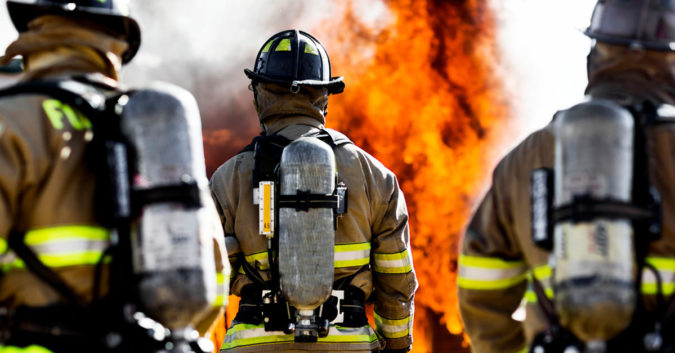January is Firefighter Cancer Awareness Month. Firefighters are twice as likely to develop certain types of cancer than the general population, according to the International Association of Fire Fighters (IAFF). As a result, occupational cancer is the leading cause of death in this field.
During the month of January, firefighters and their loved ones are urged to learn about their cancer risks and take steps to protect themselves.
Firefighters and the Risk of Cancer
Both civilian and military firefighters are at an increased risk of developing cancer because they are more likely to be exposed to a variety of hazardous substances on the job.
Hazardous materials at fire sites can often include:
- Asbestos
- Firefighting foam
- Other dangerous chemicals found in soot and smoke
The IAFF notes that, of those added to the Fallen Fire Fighter Memorial in 2023, nearly 63% of fallen firefighters died of occupational cancer, which shows just how prevalent these health risks are within the first responder community.
“Pinpointing the exact cause of cancer is extremely difficult because firefighters are not exposed to just one agent. They are exposed to multiple cancer-causing agents. Because of the multiple exposures and the multiple routes of exposure…it is also highly unlikely for firefighters to get only one type of cancer.”
– Dr. Grace LeMasters, Occupational and Environmental Epidemiologist
Firefighter Cancer Awareness Month is an important time to raise awareness about the dangers firefighters face and to advocate for safeguards, routine cancer screenings, and more.
Firefighting Foam and Cancer
Firefighters often have to work with aqueous film-forming foam (AFFF) — more commonly known as firefighting foam — to put out high-intensity fires. This foam contains dangerous chemicals known as perfluoroalkyl and polyfluoroalkyl substances (PFAS).
PFAS can build up in the body over time and cause many types of cancer and other serious health conditions, including:
- Bladder cancer
- Breast cancer
- Leukemia
- Liver cancer
- Lymphoma
- Multiple myeloma
- Pancreatic cancer
- Prostate cancer
- Renal or kidney cancer
- Testicular cancer
- Thyroid disease
- Ulcerative colitis
- Uterine or endometrial cancer
Despite these risks, the U.S. military mandated the use of firefighting foam beginning in the 1960s. Firefighting foam is still used by military firefighters today, though there are plans to phase it out by October 2024.
For more than 40 years, Sokolove Law has helped thousands of innocent workers who have gotten sick through no fault of their own. This includes the brave firefighters who put their lives on the line at work.
If you or a loved one was harmed by firefighting foam, you may be eligible to receive PFAS compensation from a lawsuit that can help pay for treatment and support your family.
Contact us now for free to see how we may be able to help your family.
Firefighters and Mesothelioma
One of the most dangerous substances firefighters may be exposed to is asbestos. This naturally occurring mineral was heavily relied upon in construction for most of the 20th century due to its fireproof qualities.
Asbestos is linked with several serious diseases, including the rare and aggressive cancer mesothelioma. This cancer can develop in the lining of the lungs, abdomen, testes, or heart.
Firefighters are two times more likely to develop mesothelioma than the general U.S. population, according to an alarming study from the National Institute for Occupational Safety and Health.
Because asbestos only becomes harmful if disturbed, it can be particularly dangerous to firefighters, who are unlikely to have advance notice of when a building might contain asbestos. This makes it virtually impossible to take precautions to prevent exposure to the deadly mineral.
While no longer widely used in construction today, asbestos continues to pose a threat to firefighters since many older structures still contain the material. This includes many residential, business, and municipal buildings, along with U.S. Navy ships and shipyards.
If you or a loved one was diagnosed with mesothelioma, you may be eligible for compensation from a mesothelioma lawsuit or claims with asbestos trust funds.
At Sokolove Law, our experienced mesothelioma lawyers have helped thousands of families nationwide secure compensation and justice from the makers of asbestos-containing products responsible for their illness.
Get started now with a free mesothelioma case review to determine your eligibility.
How Firefighters Can Reduce Their Risks of Cancer
Firefighters may be able to reduce their risk of cancer by following proper cancer prevention protocols, like:
- Cleaning suits and equipment upon returning to the station to remove toxic chemicals
- Getting routinely screened for cancers like mesothelioma, as early detection may allow for more treatment options
- Wearing protective gear like personal protective equipment (PPE) and self-contained breathing apparatuses (SCBAs)
Generally, the best way for firefighters to reduce their cancer risk is to become educated on making the safest choices. With sound work practices, firefighters may be able to reduce their exposure to hazardous substances.
Ways to Participate in Firefighter Cancer Awareness Month
Firefighter Cancer Awareness Month is a great time to support those who risk their lives fighting fires and keeping others safe.
This Firefighter Cancer Awareness Month, consider getting involved by:
- Contacting policymakers about providing disability benefits for firefighters with occupational cancer
- Donating to cancer research organizations like the Mesothelioma Research Foundation
- Participating in training programs to handle toxic substances safely to reduce exposure
- Listening to survivor stories
- Spreading the word on social media with the hashtags #FFCancerMonth or #FightFFCancer
At Sokolove Law, we are dedicated to supporting firefighters by helping them pursue compensation after an occupational cancer diagnosis.
Firefighter cancer compensation can help pay for treatments, lost wages from missed work, and other expenses.
If you or a loved one was diagnosed with cancer after working as a firefighter, contact Sokolove Law now at (800) 995-1212 to find out more about the compensation you may be entitled to.
